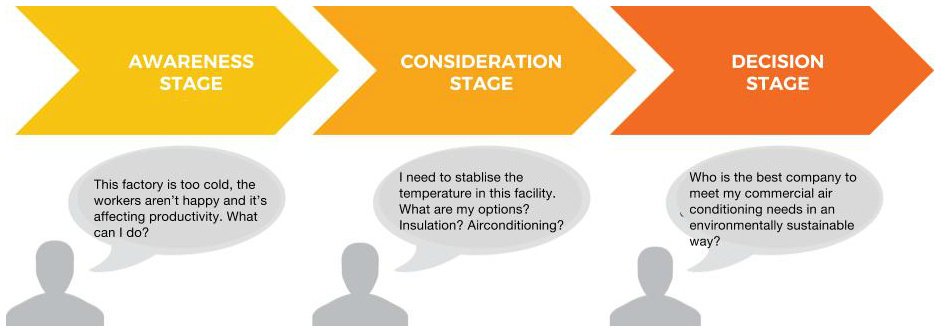Face it: Your buyer is in control. She’s smart, she knows what she wants or she knows how to find out what she needs. And all the information she requires is just a few clicks away.
So how you do you get yourself in the running to win her business?
Let’s assume you’ve already developed your Buyer’s Persona. Now you know her as a person, the next step is to understand her journey to a purchase decision. Knowing your buyer’s journey is critical so you can map your online marketing accordingly and make it to her short-list when she’s ready to purchase.
If you’ve worked out that buyers don’t want to be prospected, or closed, you’re right. The modern B2B sales person, business development professional or marketer needs to personalise the sales process to match where the buyer is in their journey to making a decision.
What is the buyer’s journey?
The buyer’s journey is the process we all go through when we are going to purchase something. It can be broken down into 3 stages. First, we become Aware of a need, then we Evaluate the alternative solutions and finally we make a Decision.
The stages under the microscope
Awareness Stage: The buyer realises they have a problem and look for information to define what it is. Example: I need to moderate the temperature in the factory, what are my options? Air conditioning? Better Ventilation? Change the work space? Relocate?
Consideration Stage: The buyer defines their problem and researches options to solve the problem and meet their need. Example: I need affordable, environmentally sustainable commercial air conditioning that is quiet and meets local regulations.
Decision Stage: The buyer chooses a solution. Example: Which of the companies that I have researched has helped me understand what I need and been instrumental in helping me solve my problem? Which has a solution that meets my need and budget and can offer support?
The graphic below illustrates a sample buyer journey of an operations manager persona going through the process of purchasing commercial air conditioning.
How do you define your buyer’s journey?
To understand your buyer’s journey conduct interviews or hold workshops with your own team, or your customers and prospects to map out each stage of the buying journey.
Awareness Stage
Here you need to identify your buyer’s challenge or an opportunity they want to pursue. In this stage they’ll be considering if they are going to be able to solve their problem or whether it’s all too hard. Ask yourself and your team things like:
- How do buyers describe their opportunities or challenges?
- How do buyers educate themselves on meeting their opportunities or challenges?
- What happens if they don’t take any action? (Think about the air conditioning example above. Do staff leave? Does productivity fall? Does a hot environment impact morale?)
- How do buyers prioritise their issues and opportunities? On cost? On risk?
Consideration Stage
In the Consideration stage, your buyer has defined the opportunity or challenge and has committed to solving or meeting it. Here they’ll evaluate the different ways to get the outcome they want. They’ll be working out if you are in the race to meet their needs, solve their challenge or help them pursue their goal. Ask yourself and your team:
- What are the categories of solutions that buyers investigate? (Reverse cycle air conditioner, commercial evaporative, energy efficient temperature control, industrial air conditioning, green air conditioning?)
- How do buyers educate themselves on the various categories? (Online, blogs? YouTube? competitor’s websites? white papers? online guides? product review websites?)
- How do buyers perceive the pros and cons of each category? (Is green energy really a driver?)
- How do buyers decide which category is right for them?
Decision Stage
By the time buyers get to the decision stage they’ve decided on a solution category. At this point they’ve completed their pros/cons review and they know what they want and need. All that’s left is to choose the provider.
To understand the Buyer in the decision stage ask yourself and your team the following questions:
- What are the criteria your buyers use to evaluate the available offerings? How are they ranked? (Energy use, noise, price, brand reputation, track record, international experience, on-ground support?)
- When buyers investigate your company’s offering, what do they like about it compared to alternatives?
- What concerns will they have?
- Who needs to be involved in the decision? For each person involved, how does their perspective on the decision differ?
- Do buyers have expectations around trying the offering before they purchase it?
- Outside of purchasing, do buyers need to make additional preparations, such as implementation plans or training strategies?
Understanding your buyer personas and each buyer’s journey will help you figure out the content you need to produce to help your buyer at each stage of their journey towards a purchase decision. Your content marketing program may include a variety of (usually online) components such as blogs, white papers, social media, infographics, ebooks and webinars.
Final Thought
Understanding your buyer and mapping your buyer’s journey to a purchase decision gives you the best chance to align your marketing and sales processes to deliver your buyers the best content. This will help your buyer choose your company the next time they’re in the market for the services you offer.

